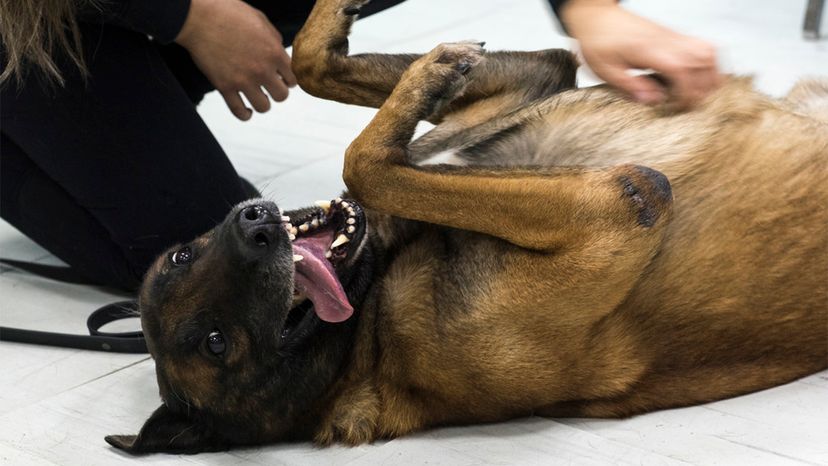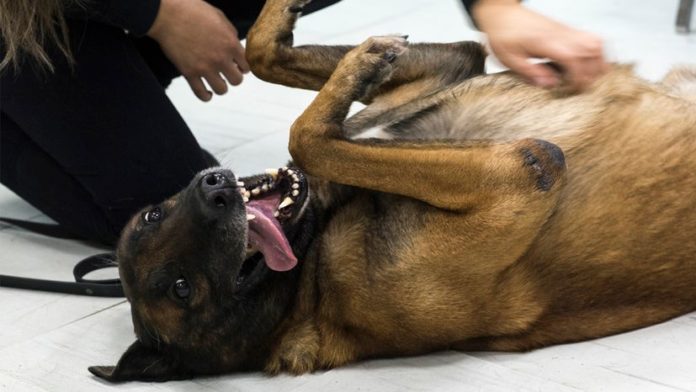 “Why do dogs love belly rubs so much? There is a specific neuron in the brains of dogs and other mammals that responds to the stimulation of hair follicles. Staff Sgt. Jeremy L. Mosier/U.S. Air Force
“Why do dogs love belly rubs so much? There is a specific neuron in the brains of dogs and other mammals that responds to the stimulation of hair follicles. Staff Sgt. Jeremy L. Mosier/U.S. Air Force
If you are enjoying some quality time with a dog or a cat, odds are that a belly rub will come into play. But have you ever wondered about the psychological, physical and even neurological underpinnings of this interaction?
A belly rub can be good for your dog on many levels. Not only does it feel great, but it mimics important socialization between dogs, who are high-touch creatures. When dogs play, they are definitely paws-on, and this means they crave frequent physical interaction from the people who make up their pack. Aside from the behavioral boost a belly rub can offer, there is a neurological component to a belly rub session. Dogs have specific neurons in their brains that light up when hair follicles are stimulated, and that provide a satisfying sensation during belly rubs.
Plus, giving a "good boi" a belly rub is so psychologically soothing that it can manifest physical benefits. Petting a doggo’s tummy can lower his heart rate and blood pressure. This "pet-effect" also can be experienced by people, who may have a blood pressure reduction when petting a dog. And, this affection connection with your pet acts as a feel-good drug. When you and your furry beloved stare into each other’s eyes during a belly rub, you’ll both experience a hefty spike in oxytocin — the same hormone that creates a "love chemical" feedback loop between mothers and their babies.
How will you know whether a dog wants a belly rub? Dogs often make it really easy to tell, but that doesn’t mean you should just dive-in to a vigorous tummy rub with great abandon. Check the dog’s posture. Is he relaxed? Tongue lolling out? Accepting of head pats or ear rubs? Start with the head, and you’ll discover that relaxed dogs will melt to the floor and roll over to give you better access to their bellies. If a dog is anxious, which can manifest as a rapid and submissive flip to expose the belly, then it’s not a good idea to give them a pleasurable pet because this can reinforce the nervous feelings they are experiencing. While most breeds love a massage on the tummy, there will be dogs of any breed who are not comfortable with this kind of vulnerability and exposure. Let the dog lead the way.
And that brings us to cats. Mysterious and persnickety, these bundles of fluff, claws and teeth are determined to make their own way in the world, and this might — or might not — mean allowing you to rub their bellies. For starters, those sensitive hair follicles on the feline tummy are easy to overstimulate. This may explain why cats sometimes appear to want a belly rub, but then suddenly bite or rabbit-kick their back legs to stop the rub.
And, because cats are big predators in little bodies, they aren’t likely to experience pleasure from exposing their bellies, with all their tender vital organs just centimeters under their soft, furry skin. Touching this delicate spot, especially when a cat is otherwise relaxed on his back, can trigger defensive moves that involve teeth and claws. That said, there are some cats who absolutely adore belly rubs, which is likely part of a plot to retain their collective status as enigmas.
Now That’s Interesting
When cats roll over on their backs, they’re not generally showing submission, or the desire to have you touch their belly. It’s actually a defensive position that gives them the ability to use all of their claws and teeth to protect themselves from predators.








































